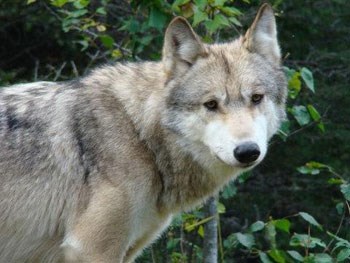By Kathy Morrell
"The animal has long been the subject of myth and misunderstanding," says Paul Paquet, wolf expert. The researcher and academic will present his case for the wolf at the annual Symposium of the Yellowhead Flyway Birding Trail Symposium to be held April 28 in Saltcoats.
"It seems to me that wolves follow the cycle of deer population numbers," adds fur trapper Ron Nimetz. "Right now I see evidence of a lot of wolves along my trap line and even on the country roads. Right now there are a lot of deer. That's why there seem to be a lot of wolves."
"That's when people become concerned, when they see or hear a lot of wolves," Paquet comments. "There seems to be an emotional, visceral response to a wolf howl. It almost makes your hair stand on edge, but we have to look at the facts behind that reaction and the bad reputation that the wolf has acquired.
"There is a lot we don't know about the animal in the province," he continues. "We do know that some wolves are a hybrid of the wolf and the coyote. How many we don't know and we don't know the effect on the wolf as a result of this hybridization either. More research is required.
"Most importantly, people fear the wolf, but you have to keep things in perspective. Only one or two humans have been killed by wolves in North America in the last 150 years. Hunters have killed 50,000 to 60,000 people over the same period of time, 10,000 in North America.
"All large animals are dangerous," Paquet adds. "There have been more attacks by elk, moose and deer resulting in injury and death than there have been attacks by wolves. The message is you have to be careful around any large animal.
"One of the biggest difficulties is predation on livestock and on target animals for the big outfitters.
"Some ranchers and farmers are harder hit than others because the lay of their land creates good habitat for the animal and ideal den sites for the young. Despite this, some preventative measures have been successful. The first is to keep the area clean of the bone piles that attract the animals. The second is to monitor the stock. Free range grazing creates problems. Sometimes, livestock people assume an animal has been killed because of wolves when in fact, the death has been caused by lightning, disease and even cattle rustling."
More study has to be done to mitigate the problems associated when wolves live in ranching and farming areas of the province.
"More tolerance and acceptance, too," Paquet adds.
The wolf is a controversial animal just as it has been in the past.
Long the subject of myth and story, the wolf has created a persona all its own. There are many expressions people use every day, idioms that speak to the animal's reputation: a lone wolf, hungry as a wolf, a wolf in sheep's clothing, to wolf down your food, to throw to the wolves and to keep the wolf from the door. All speak to the animal's savagery, but is that opinion justified?
Probably not.
People are fascinated by wolves. Careful and caring parents, they raise their young in family configurations. They adapt to almost any environment from mountain to desert and everywhere in between. They allow for great diversity. For example, the dog, descended from wolf genetics, shows a kind of variety unknown among any other species. Mutually dependent on each other, wolves are aware of the habitat in which they live, passing on to their young how to hunt for prey in a given area and even how to live within the boundaries of a conservation area where they are safe from hunting.
At the Symposium, Paquet will describe his research into coastal wolves along the British Columbia Coast. They are a unique group with aquatic life (clams, octopus, salmon and whale) as their sources of food.
The presentation promises to be interesting, entertaining and perhaps even controversial.
This year, the Symposium will be held April 28 at the Saltcoats Community Hall. The day-long event includes lunch and supper and speakers Sarah Vinge, plant conservationist and Dr. Jerry Haigh, wildlife veterinarian in
Africa and Canada. Cecil Machnee of Canora, will tell the tales of the fur trade along the upper Assiniboine between the present-day towns of Kamsack and Sturgis.
Further information about the Symposium is available at www.yfbta.com.
- Submitted by Rob Wilson, Yellowhead Flyway Birding Trail Association




